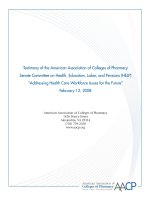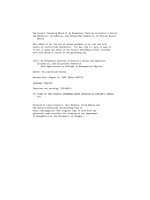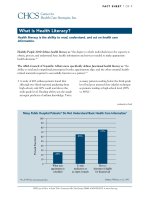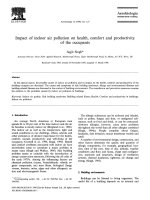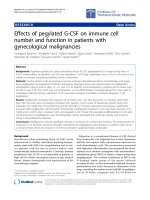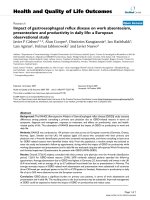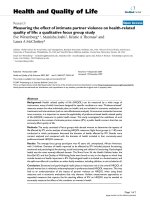Testimony of the American Association of Colleges of Pharmacy Senate Committee on Health, Education, Labor, and Pensions (HELP) “Addressing Health Care Workforce Issues for the Future” February 12, 2008 pptx
Bạn đang xem bản rút gọn của tài liệu. Xem và tải ngay bản đầy đủ của tài liệu tại đây (79.17 KB, 6 trang )
American Association of
Colleges of Pharmacy
Discover · Learn · Care: Improve Health
Testimony of the American Association of Colleges of Pharmacy
Senate Committee on Health, Education, Labor, and Pensions (HELP)
“Addressing Health Care Workforce Issues for the Future”
February 12, 2008
American Association of Colleges of Pharmacy
1426 Prince Street
Alexandria, VA 22314
(703) 739-2330
www.aacp.org
American Association of
Colleges of Pharmacy
Discover · Learn · Care: Improve Health
Thank you for the opportunity to present testimony to the Senate Committee on Health, Education,
Labor, and Pensions (HELP). The issue of a health professions workforce is of national and international
concern. My testimony will be provided without the benefit of accompanying graphs and charts. Infor-
mation regarding the pharmacist workforce, as well as any other health professions workforce, is readily
accessible to you and your staff. My intention is to briefly describe why we need:
a federal presence in the development of a comprehensive health professions workforce strategy; and1.
an incremental strategy that can assist in the strategy development.2.
Regarding the international implications of our lack of a comprehensive federal health professions work-
force strategy I will direct you to the recent report of the World Health Organization (WHO). The follow-
ing statement of the WHO Global Health Workforce Alliance supports my contention that we must work
now, in a comprehensive manner, to address our nation’s health workforce needs. “We will not view the
workforce in isolation, but as the principal component in strengthening health systems and tackling pri-
ority health problems – all integrated into a nation’s health and development priorities.” [1]
The Bureau of Labor Statistics, in their Occupational Outlook Handbook, shows that the demand for al-
most all health professions will remain strong. [2] Individual health professions and federal agencies can
relate current snapshots of the health professions workforce. [3] Today we should remove ourselves from
the issue of quantity and discuss our next steps in the area of a health professions workforce in terms of
quality. The connection between our health professions workforce and the quality of care patients receive
is well stated in the Institute of Medicine’s report “Health Professions Education: A Bridge to Quality,”
published in April of 2003. [4]
This report recommends that health care professionals be competent in:
providing patient-centered care;•
working as part of an interdisciplinary team;•
practicing evidence-based medicine;•
focusing on quality improvement; and•
using information technology.•
The benefits of collaboration and interprofessional work are now recognized as essential elements of the
work of important federal agencies. The National Institutes of Health (NIH) supports collaboration across
the health professions in its programs including:
multiple primary investigators;•
interdisciplinary and interprofessional grant programs;•
the Clinical and Translational Science Awards (CTSA) programs; and•
the creation of the Council of Councils and the Common Fund.•
The Food and Drug Administration is working towards a multidisciplinary approach to science and regu-
lation that supports its mission.
This form of collaboration is a new concept built out of the need to reinvigorate and improve the quality
of our academic research enterprise, speed up the translation of new knowledge to benefit patients and
recognize that shared resources bring efficiencies and sustainability to our nation’s research platform. Our
approach to improving health care quality through health professions education can support this culture
change happening in our research community. We must now prepare our health professionals to speed
up their delivery of evidence-based care so the quality of care patients receive is improved. Interprofes-
sional education provides the basis of this preparation.
American Association of
Colleges of Pharmacy
Discover · Learn · Care: Improve Health
How can we accomplish this?
An important part of a comprehensive federal health professions workforce strategy is the education of
health professionals. Currently, Title VII of the Public Health Service Act (42 USC Section 293 et seq.)
comprises the totality of federal policy directed towards health professions education. As a component
of a comprehensive federal health professions workforce strategy, Congress should reauthorize the Title
VII programs by making the majority of the programs, including those addressing residencies, faculty
development and curriculum development, interprofessional in nature and focused on issues of state
or national concern.
Current law precludes colleges and schools of pharmacy from directly participating in Title VII pro-
grams other than the diversity programs, geriatric education centers, and the currently unfunded
Quentin Burdick Rural Health programs. Colleges and schools of pharmacy are currently participants
of the interprofessional Area Health Education Centers program. In light of the growing participation
of the Doctor of Pharmacy (Pharm.D.) in both inpatient and ambulatory care teams, it is imperative
that reauthorization of these programs become interprofessional, allowing colleges and schools of
pharmacy to seek grant funding.
What is interprofessional education?
AACP members have developed an interprofessional framework that is attached to this testimony.
From the report:
“Interprofessional education involves educators and learners from two or more health professions and
their foundational disciplines who jointly create and foster a collaborative learning environment. The
goal of these efforts is to develop knowledge, skills and attitudes that result in interprofessional team
behaviors and competence. Interprofessional education is incorporated throughout the entire curricu-
lum in a vertically and horizontally integrated fashion.
Interprofessional Education IS NOT: A few examples of what interprofessional is not include: students
from different disciplines in a classroom receiving the same learning experience without reflective in-
teraction among students of the various disciplines; a faculty member from a different discipline lead-
ing a classroom learning experience without relating how the disciplines would interact in an interpro-
fessional manner of care; and participating in a patient care setting led by an individual from another
discipline without sharing of decision-making or responsibility for patient care.” [5]
The taskforce continues to consider issues related to curriculum development and faculty development
that will support a broader implementation of interprofessional health professions education through-
out our Academy.
Academic pharmacy is not working on this issue of interprofessional education alone. As mentioned
above, colleges and schools of pharmacy are actively engaged with other health professions education
organizations to identify opportunities and challenges to the development of successful interprofes-
sional health professions education programs. Attendees at this hearing should be able to describe the
work of health professions education organizations convened by the Joint Commission, the Institute
for Health Improvement (IHI) and the Federation of Associations of Schools of the Health Professions
(FASHP). The work of IHI reflects the approach suggested here in this testimony and is stated by Dr.
Paul Batalden: “This preparation for interprofessional practice can be guided by the common aim of
the improvement of patient care.” [6]
What do we need to accomplish this?
“Although implementation details vary from one organization to another, the extent to which
nurses, pharmacists and physicians collaborate to design and implement the process will
determine its ultimate impacts in improving patient safety and realizing desired efficiencies.” [7]
American Association of
Colleges of Pharmacy
Discover · Learn · Care: Improve Health
This statement by Joint Commission President Dennis O’Leary clearly identifies interprofessional collabo-
ration as an essential element of improved patient safety and therefore the quality of care patients receive.
This testimony brings to your attention the ongoing work to create a safer, higher quality health care
delivery system. The opportunities for improved quality through team-based care have long been known.
To date, the barriers to educating health care professionals competent to delivery team-based, patient-
centered care have stymied systematic and wide-spread development and implementation of interprofes-
sional health professions education.
Therefore, as a part of a comprehensive federal health professions workforce strategy, Title VII of the
Public Health Service Act should be reauthorized. The goal of the Title VII programs should be to improve
the quality of health care delivered in the United States through a diverse health professions workforce
educated and trained to provide evidence-based, patient-centered, team-based care that focuses on quality
improvement and is supported by informatics.
This goal will be supported through federal grant programs that require the combined academic interests
of two or more health professions. These grants should be considered research grant support as they will
be offered in the context of knowledge development and best-practice analysis. The federal grant pro-
grams will support:
academic-based programs that help promote health professions education to elementary, second-•
ary and undergraduate students, with emphasis on underrepresented populations;
academic-based programs that assist health professions institutions in the development of organi-•
zational infrastructure such as faculty, curriculum and residencies that focus on state or national
priorities (e.g. geriatrics, primary care, rural, underserved, health promotion and wellness) and are
interprofessional in nature; and
information technology improvements that will allow multiple academic institutions to develop •
interprofessional educational programs.
Academic-based programs applying for such grants will be required to:
state expected outcomes of the program;•
address the sustainability of the program; and •
prepare a satisfactory program evaluation at the conclusion of the grant and at intervals deter-•
mined by the federal government.
Conclusion
It is clear that there is a compelling federal interest in improving the quality of health care delivered to
patients. The competitive grant process is an effective mechanism for surmounting organizational and
infrastructure barriers that inhibit quality improvement through the development of interprofessional
health professions education opportunities. Now is the time to act. We know that the high demand for
all health professions will be sustained. Meeting the health care needs of our country during periods of
high demand require a health professions workforce that works effectively and efficiently together on
behalf of the patient. Highly regarded individuals tell us that we can improve the quality of patient care
through developing team-based, patient-centered care. Our biomedical enterprise recognizes that contin-
ued preeminence of our enterprise depends on interprofessional collaboration. Interprofessional health
professions education has been discussed for decades. The barriers to interprofessional health professions
education can be weakened through federal incentives. It is in the best interest of Congress to create these
incentives. These incentives can be offered through the Title VII health professions education programs.
American Association of
Colleges of Pharmacy
Discover · Learn · Care: Improve Health
About AACP
Founded in 1900, the American Association of Colleges of Pharmacy (AACP) is a national organization
representing the interests of pharmacy education and educators. Comprising all 105 U.S. colleges and
schools of pharmacy including more than 4,300 faculty, 48,500 students enrolled in professional programs
and 3,600 individuals pursuing graduate study, AACP is committed to excellence in pharmacy education.
To learn more about AACP, visit its Web site at www.aacp.org.
[1] />[2] />[3]
and
/>[4] />[5] />[6] />alsCapableofContinuallyImprovingHealthCareQuality.htm
[7] />American Association of
Colleges of Pharmacy
Discover · Learn · Care: Improve Health
Summary of Testimony presented to the Senate Committee
on Health, Education, Labor, and Pensions (HELP)
American Association of Colleges of Pharmacy (AACP)
Recommendation:
As a component of a comprehensive federal health professions workforce strategy, Congress should reau-
thorize the Title VII programs by making the majority of the programs, including those addressing residen-
cies, faculty development and curriculum development, interprofessional in nature and focused on issues
of state or national concern.
Current Law:
The Public Health Service Act Title VII health education programs are authorized under 42 USC Section
293 et seq.
Background:
According to the Bureau of Labor Statistics, a large number of health professions can expect aver-•
age or greater than average job growth through 2014.
The demand for health care professionals will exceed the supply for the foreseeable future. •
Our ability to meet that need is compromised and new approaches, such as team-based care, •
should be supported as a way to extend the health care team so high quality care and consistent
messages of health and wellness can be delivered.
Our approach to health workforce recruitment and retention has international impact.•
As part of a comprehensive federal health professions workforce strategy, Title VII of the Public Health
Service Act should be reauthorized. The goal of the Title VII programs is to improve the quality of health
care delivered in the United States through a diverse health professions workforce educated and trained
to provide evidence-based, patient-centered, team-based care that focuses on quality improvement and is
supported by informatics.
This goal will be supported through federal grant programs that require the combined academic interests
of two or more health professions. These grants should be considered research grant support as they will
be offered in the context of knowledge development and best-practice analysis. The federal grant pro-
grams will support:
academic-based programs that help promote health professions education to elementary, second-•
ary and undergraduate students, with emphasis on underrepresented populations;
academic-based programs that assist health professions institutions in the development of organi-•
zational infrastructure such as faculty, curriculum and residencies that focus on state or national
priorities (e.g. geriatrics, primary care, health promotion and wellness) and are interprofessional in
nature; and
information technology improvements that will allow multiple academic institutions to develop •
interprofessional educational programs.
Academic-based programs applying for such grants will be required to:
state expected outcomes of the program;•
address the sustainability of the program; and •
prepare a satisfactory program evaluation at the conclusion of the grant and at intervals deter-•
mined by the federal government.
For more information:
William Lang, MPH
VP Policy and Advocacy
703-739-2330 x1038
February 7, 2008
